The Conservatives will continue in government after yesterday’s federal election, but the election produced a radically changed Parliament and political climate. The Conservatives gained a majority after two unstable minority governments, while the left-wing New Democratic Party reduced the opposition Liberal Party to third-party status and almost eliminated the separatist Bloc Quebecois.
Nationally, the Conservatives only gained a swing of 1.9% nationwide, but there was a much larger shift amongst left-leaning voters. The Liberal Party’s vote dropped from 26.3% to 18.9%, while the NDP vote jumped from 18.2% to 30.7%. The Bloc Quebecois vote dropped from 10% to 6.1% nationally. The Green Party’s vote dropped from 6.8% to 3.9%.
The Conservatives won their long-sought majority, going from 143 to 167 seats. The Liberal Party’s seats collapsed from 77 to 34, with the NDP going from 37 to 102. The Bloc Quebecois, who have dominated Quebec’s seats in Ottawa since 1993, were almost wiped off the map, falling from 49 seats to 4. The Green Party’s leader Elizabeth May won the party’s first seat in the British Columbia riding of Saanich—Gulf Islands. This follows the success of Green parties in winning the first seats in national single-member parliamentary chambers in the United Kingdom and Australia over the last year.
There were few changes in the Western provinces. The numbers remained the same in Saskatchewan and Alberta, each of which elected an almost entirely Conservative delegation, with the exception of a single Liberal in Saskatchewan and a single NDP member in Alberta. The Conservatives won two of the NDP’s four seats in Manitoba. In British Columbia the Conservatives lost one of their seats to the Green Party while the NDP won three of the Liberal Party’s five seats.
In the Maritime Provinces, the NDP gained two seats off the Liberal Party and the Conservatives gained three. The main changes took place in the largest provinces of Quebec and Ontario. The Conservatives also won Yukon off the Liberal Party.
Ontario, Canada’s largest province, was dominated by the Liberal Party as recently as 2004, when the party held most seats in Toronto and Northern Ontario, and a majority in regional parts of Ontario. Over the last two elections the Conservatives and the NDP have made inroads, with the NDP dominating Northern Ontario and the Conservatives taking most seats in Central and Southern Ontario, but the Liberal Party held on to most of Toronto.
In 2011, the Liberal Party lost 26 of their 32 seats in Toronto, losing seats to the NDP, but losing many more to the Conservatives. The NDP had only held two seats in Toronto before this election, those held by NDP leader Jack Layton and his wife Olivia Chow. Six more NDP MPs were elected yesterday, along with an extra twenty Conservatives. Those twenty Conservatives gave the party the majority government it had long strived to win. The party didn’t make anywhere near enough progress outside Toronto to form a majority, and indeed went backwards in Quebec and British Columbia.
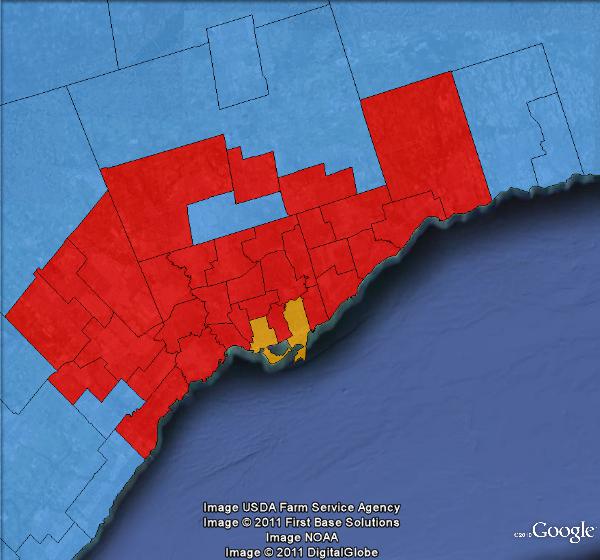
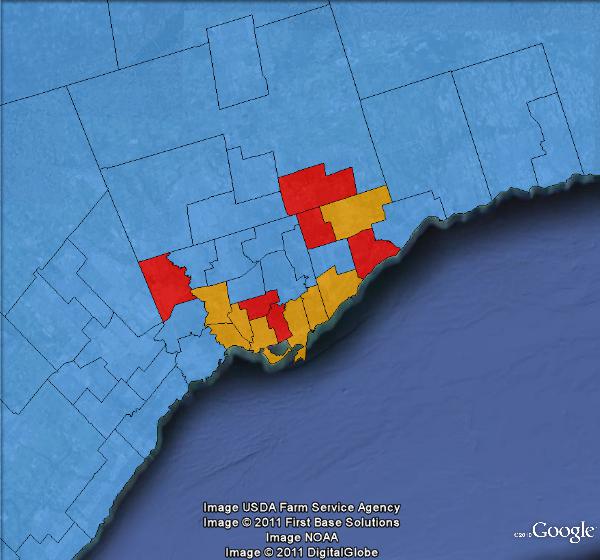
In Quebec, the result was much more dramatic. The Bloc Quebecois had dominated Quebec federal politics since 1993. At every election in that period they won between 38 and 54 seats out of a total of 75 in Quebec. They won 49 seats in 2008. This time around, the party was wiped out, with only four surviving. Bloc leader Gilles Duceppe lost his own seat, along with most of his caucus. Most of those seats went to the New Democratic Party, who have traditionally been locked out of Quebec.
The NDP won their first seat in Quebec at a 2007 by-election, and retained that one seat in 2008. This time they won 58 seats, including many they couldn’t have imagined they could win. A majority of the NDP’s new caucus comes from Quebec. The Liberal Party’s seats halved from 14 to 7, while the Conservatives went backwards from 10 to 6. The NDP dominated every region, winning most seats in the sparsely-populated north and northwest of the province. The party also won all seats in Quebec City and a large majority in Montreal. While the NDP did well in other regions, they would have been even with the Liberal Party on seats if it weren’t for the huge changes in Quebec.
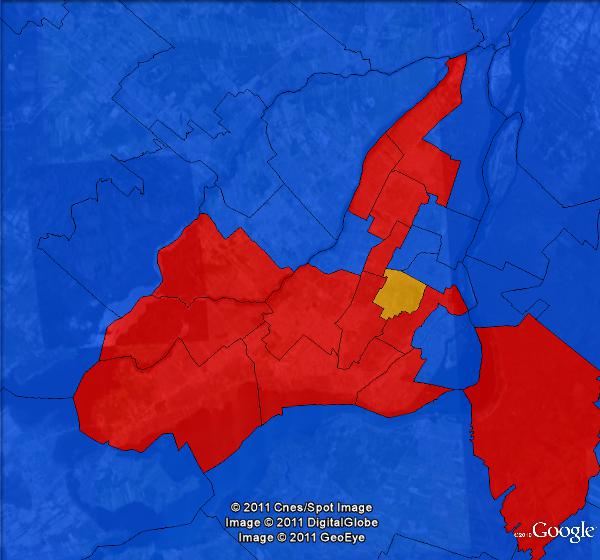
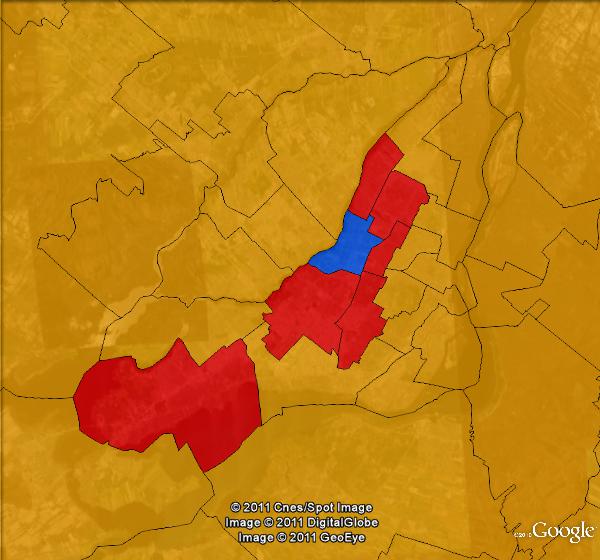
So how did the Conservatives manage to achieve their majority? There are two key explanations. The first centres on Toronto, where the Conservatives gained twenty seats. In the rest of the country the party lost five seats and gained nine. Without the Toronto gains we would have faced a third Conservative minority government. The Liberal Party lost 26 seats in the region, a majority of their 43 losses across the country.
The Conservatives also benefited enormously from vote-splitting amongst left-wing parties. Over 59% of votes were cast for the New Democratic Party, the Liberal Party, the Bloc Quebecois and the Green Party. There were many seats where strong campaigns from the NDP and collapsing Liberal votes allowed the Conservatives to gain the seat. I haven’t had an opportunity to do more detailed analysis, but I’m sure there’s many seats that the Conservatives wouldn’t have won under a preferential voting system. It is certainly true that a proportional voting system would make it very difficult for the Conservatives to ever form a government. There are many severe distortions in terms of vote numbers and seat numbers, both on a federal level and in different provinces. I may do another post on the implications for electoral reform from this election result later this week.
Since the rise of the Bloc Quebecois in 1993 and the rebuilding of the Conservatives in the early 2000s, it has been a theory that neither party could form a majority without making substantial inroads into Quebec. In 2008, Harper put a lot of effort into winning seats in Quebec. This time his strategy largely ignored the province, and he managed to form a government with his majority almost entirely based in the West and Ontario. This majority, however, was largely due to the complete collapse of the Liberal Party. If these seats are recovered by the centre-left in the future, either by the NDP absorbing what is left of the Liberal Party or the Liberals winning back NDP protest votes, it will become very hard for the Conservatives to continue in government. This election had many of the hallmarks of a Conservative landslide, but only produced a small majority in the best of times.
The biggest change in this election was the complete collapse of the Bloc Quebecois and the emergence of the NDP as the party of choice in the province. Quebec has a solid history of wild swings and diverging from the rest of the country. The BQ’s rise in 1993 took place entirely in one election, jumping from no seats to 54. The 2007 Quebec provincial election saw the centre-right ADQ jump from 4 seats to 41, forming the opposition in a hung parliament. They collapsed back to 7 seats in 2008. While the collapse of the Bloc is definitely a blow to the cause of Quebec sovereignty, it can’t be taken as a sign that the issue is dead. The Parti Quebecois, the provincial equivalent of the Bloc, has been consistently leading in the polls for the next provincial election.
It seems that the Bloc’s decline has more to do with their lack of relevance to federal politics. Apart from the issue of sovereignty, the Bloc’s political positioning and attacks on the Harper government were very similar to the NDP, but with Quebec sovereignty out of the spotlight, the NDP had an advantage due to their stronger national focus, and ended up taking the Bloc’s territory.
The Green Party was overshadowed in this campaign by the collapse of the Liberal Party and the Bloc, and the rise of the NDP, but it was a key election for the Green Party. The party focused its energy on a single constituency, and ended up comfortably electing Elizabeth May as the party’s first MP. This decision, however, saw the party fall backwards in the national vote, from 6.8% to 3.9%. Unlike Australia, there is no Senate that forces political parties to spread out their resources and develop a national grassroots organisation. There are much stronger temptations to centralise money and power in an organisation that can funnel resources to a single seat. In contrast, a minor party needs a large network of activists on the ground to compete in a statewide Senate race without the money to compete on a wide scale.
After a very unusual election, we should see Canadian politics settle down. The Conservative government will struggle to maintain their majority at a future election, so are likely to run out the full four years of their parliamentary term. It is yet to be seen how effective the NDP are as an opposition, and whether they can mop up Liberal votes in ridings where a split left vote saw the Conservatives win in 2011. This could give the NDP a shot at a majority in 2015. It is also possible that the NDP’s domination over the Liberal Party and the Bloc could prove illusory, and the defeated parties could make a recovery at the next election. The problem for the Conservatives is that, in either scenario, the party has effectively reached its ceiling in terms of electoral representation, and will have to perform strongly to maintain their majority for a second term.
I have already uploaded new version of the Canadian time-series maps and the index map of the House of Commons boundaries to the maps pages of this blog.
Here are some more maps showing the change in results in Ontario and Quebec over the past four elections:
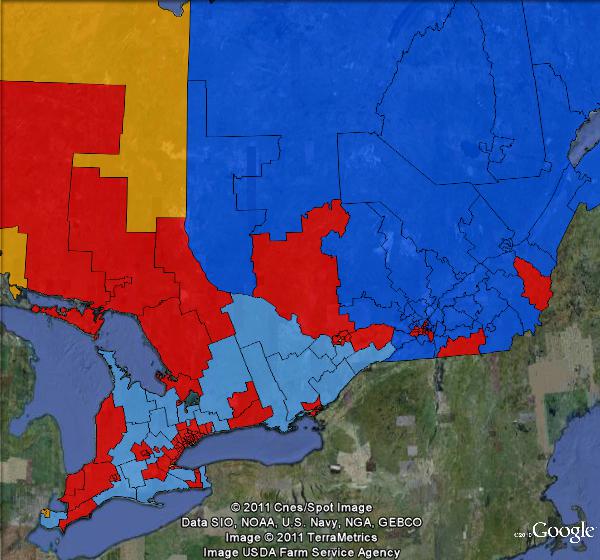
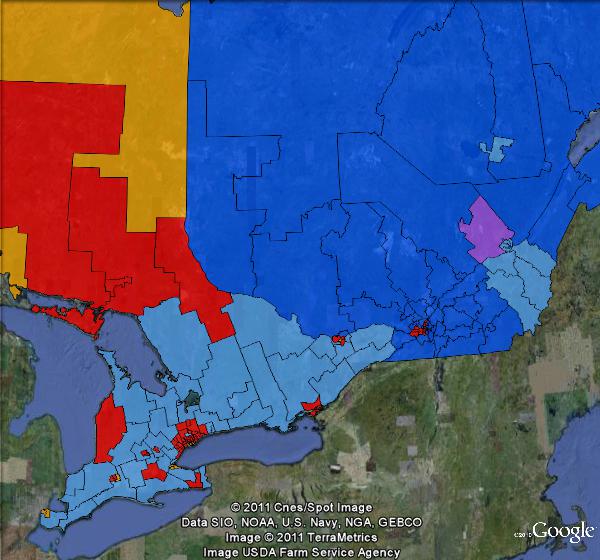
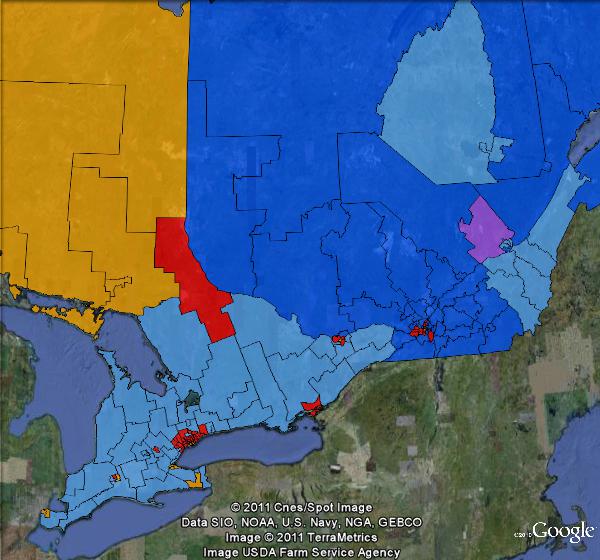
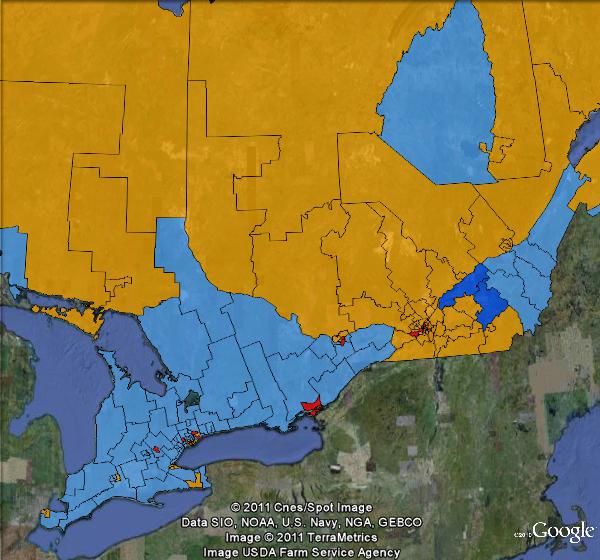



A good analysis overall.
A couple of things though.
In your analysis of Ontario, you accidentally call it Quebec more than once.
Also, the Conservatives are generally shown on maps as being dark blue while the Bloc was always a lighter blue.
I do think that there has been a drift to the right in Canada over the last decade, along with a lot of fearmongering by the parties of the left about the terrible things that would happen if there was ever a Conservative government, and later, a Conservative majority. The Liberals ran some embarassing ads in 2006 claiming that Stephen Harper was itching to turn Canada into a military dictatorship.
http://www.youtube.com/watch?v=uMsqEph7a8I
“Canadian cities… soldiers with guns… in our cities… in Canada.”
This kind of hubris didn’t take though, and it seems to be having less and less impact at every election. The Liberals often like to refer to themselves as Canada’s natural governing party. That was always an arrogant assumption, but it seems to have caught up with them now.
Thanks Bill, I fixed the typo.
I know that the Conservatives and Bloc Quebecois colours should be strictly reversed.
However I try and keep my colours relatively consistent across different countries, so I use the same shade of red for Liberal, Labour, Labor, etc, and the same blue for Conservative, NZ National, Australian Liberal. The darker blue is rather hard to decipher so I don’t use it for major parties. Hence the reversal of colours.
Fascinating post, Ben.
I think there is much more positive in this result than your analysis allows, however. Despite the party’s recent trend to moderation, the NDP vote has always represented a more clearly Left and class-based aspiration than the Liberals (who are really another Tory party and not so clearly “of the Left” as you imply).
This means we can see this election as a process of political polarisation, similar to what is happening elsewhere around the world. The global economic crisis, while it hasn’t hit Canada as hard as its US neighbour, is speeding up this process. I’d suggest the BQ’s nationalism therefore sat less well than the NDP’s more class-based populist rhetoric in such circumstances.
That’s why I wouldn’t be so sure that “we should see Canadian politics settle down” after this election. An absolute majority doesn’t always prevent governments falling in situations of social crisis and polarisation, and it seems likely to me that Harper will see this as a mandate to go on the front foot attacking the working class. The outcome of struggles outside parliament may shape what goes on within its walls much more than is apparent right now.
Could you put the Bloc seats in another colour? You used to have them in turquoise, or does that not work well with higher opacity you’re using now?
You have a couple of mistakes on the screenshots of Toronto and Montreal. In each the Liberals should have one extra seat. In Toronto I believe the seat you have wrong is York West. In Montreal it appears to be Westmount-Ville-Marie.
I checked the map file against the seat totals for each province, and there’s one more error I’ve found in Nova Scotia. Halifax West should be Liberal not NDP. Otherwise everything else looks right.
An average analysis. The NDP surge in Quebec will wither and die when it is realised that the NDP will never be able to form a majority Government and give the Quebecois what they want. The NDP can never win enough seats in the Western provinces to win majority government.
The big mistake many analysts is trying to work out what would have happened if AV had been in place instead of FPTP. If voters had been given the chance in Canada to give preferences, and the parties had distributed preferences, I suspect that 60% of the Liberal vote and half of the Bloc vote would have gone to the Tories. What you have to remeber is that the Liberals in Canada are like the Liberals in Britain and Australia in the 19th and 20th centuries, a party with a strange mix of right wing toffs and left wing loonies. Ths is a terrible mish-mash that for some reason has survived in Canada whwn it has failed everywhere else. it is now dead. And like in Britain between the Wars we will see the Liberal vote split between the Tories and the NDP. The Tories will get the bigger share because they are far more mainstream. The NDP has a lot of loony left policies. This means it has reached its ceiling with this election, unless it becomes more moderate.
The other difficulty in doing the AV would be to allow for regional differences the impact would have differed between regions – AV in Quebec would not have helped the Tories at all as the competition was between the Bloc, the Liberals and the NDP.
In Ontario there were a lot seats at stake – you would have to look at the order of finishing of the Tories, Liberals and NDP – an AV may have had the result of Liberals retaining seats that went to the Tories on the basis of NDP preferences.
In Ontario the Liberals were running third, so their prefernces would have been the key. I suspect that 60% of them would have gone to the Tories, as the NDP are seen as loony lefties by many economically conservative Liberal voters according to the Globe and Mail.
Peter the Lawyer is correct – the Canadian liberal party at its peak was a very broad church of small l liberals, and social democrats that historically sat on the centre-left of Canadian politics.
Now it’s caught in the middle, with some of its more right wing voters going to the tories, and some of the more left wing voters going to the NDP. It’s now stuck as an ill-defined “centrist” party, that looks like it’s standing for nothing. No wonder it came third.
I disagree with the predictions made in this post. This is the NDPs highwater mark. It will be fairly easy for the conservatives to run a negative campaign against the NDPs more extreme policies and describe the Left as a chaotic circus, which if you read your post it is. At the next election the Liberals will fight back and the seat numbers will be reversed, but this will mean another vote split that will allow the conservatives to win. Maybe the election after that?
Comments are closed.